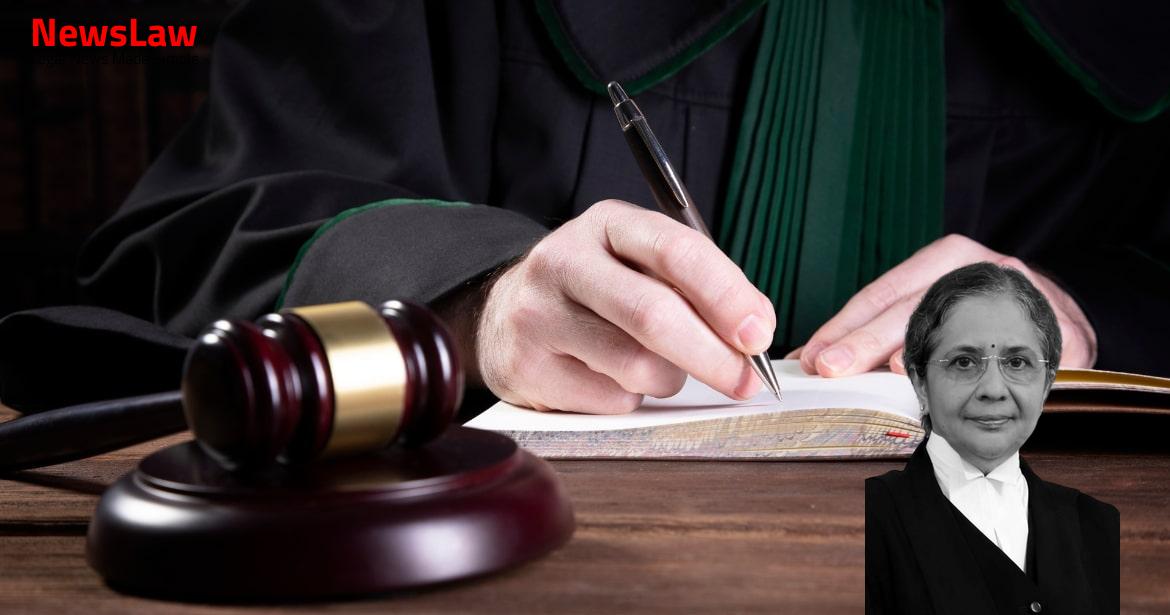Though pursuant to order dated 22.09.2003, efforts were made to sell the property of respondent no.3 in three lots, finally, based on an auction for a consolidated sale, the second respondent herein, namely, M/s. No 1203 of 2004 at the instance of the second respondent, the Official Liquidator was accorded permission by the learned Company Judge to execute the sale deed in favour of the first respondent in the appeals, viz, M/s. WHEREAS the Official Liquidator has put the properties of the Company for sale in terms of orders of the Hon’ble High Court and whereas the Hon’ble High Court of Andhra Pradesh, Hyderabad by an order dated 04-02- 2004 made in C.A.No.736/2003 in R.C.C.No. WHEREAS the Vendee has paid the full consideration to the vendor within the time stipulated by the Hon’ble High Court of Andhra Pradesh, Hyderabad and as per the terms and conditions of the sale, properties have been sold by the Vendor to the Vendee on ‘as is where is whatever there is basis’. WHEREAS the land to an extent of Acres 46.7167 cents situated in Dusi Village as per details given below is now registered in favour of the VENDEE through this document, hereinafter referred to as the ‘SCHEDULED PROPERTY’ for brevity, which is fully described in the schedule of property and clearly delineated in red colour in the plan annexed hereto. Since the sale deed in favour of the nominee, namely, the first respondent came to be executed pursuant to order of the Company Judge dated 15.06.2004 made in C.A. They read as under: “Application under Section of the Companies Act, 1956 R/W Rule 9 of the Companies (Court) Rule, 1959, praying that this High Court may be pleased to direct the Official Liquidator to execute the sale deed in respect of the land and building and civil works belonging to the company in liquidation fora consideration of Rs. Anil Kumar, Counsel for the Official Liquidator on behalf of the respondent” “… The learned counsel also placed before me Form No.32 issued by the Office of Registrar of Companies, Calcutta, showing that Sri Amit Ganguly, S/o late B.N. Insofar as the relief in the application to direct the Official Liquidator to execute the sale deed in favour of M/s Dunkuni Steels Limited for a consideration of Rs.40, 13,000/- (Rupees forty lakh and thirteen thousand only) is confirmed in the auction conducted by this Court, as the land, building and machinery of the company in liquidation was sold to the applicant company at a price of Rs.8,35,00,000/- (Rupees eight crore thirty five lakh only), it would be better if the issue as to the value of the property in respect of which a conveyance deed has to be executed is decided by the Registration Authorities. No.9, Industries & Commerce Department, dt.5.1.2001, enunciating a New Industrial Policy for 2000- 2005.
Basing on the above decision, the following Notifications will be published in the next issue of the Andhra Pradesh Gazette:- NOTIFICATION – I
Also Read: https://newslaw.in/case-type/civil/application-of-code-of-civil-procedure-in-small-causes-court/
In exercise of the powers conferred by clause (a) of sub-section -(1) of section 9 of the Indian Stamp Act, 1899 (Central Act II of 1899), the Government of Andhra Pradesh hereby reduces the stamp duty by 50 percent on the instruments of leases, lease-cum-sales and sales executed in favour of Industrial units and also remits Stamp Duty in full on laan agreements, credit deeds, mortgages and hypothecation deeds executed by such Industrial units in favour of banks or financial institutions for the purposes of setting up or expansion or development of Industries. NOTIFICATION – II
In exercise of the pwers conferred under Section 78 of the Registration Act, 1908 (Central Act XVI of 1908), the Governor of Andhra Pradesh hereby makes the following amendment to the “Table of Fees” – issued in G.O. The Sub-Registrar, namely, the first appellant by communication dated 12.08.2004 informed the first respondent that the registration was kept pending for the following reasons: The chargeable value as per the contents of the documents was assessed to be Rs.8.35 crores whereas respondents 1 and 2 had stated that only the land and buildings were being transferred for Rs.1,01,05,000/-. Therefore, the fact that the Company Court originally directed sale of the assets of the Company in three lots has no relevance for deciding these petitions because second petitioner, admitted1y, purchased the assets of the company as one lot only, in the open auction held by the Company Court, but not as three different lots. This provision, far from helping the petitioners, would go against their contention that sale deed can be executed for Lot l only, inasmuch as assets of the company were advertised for sale in three lots, because all the three assets of the company were purchased by the second petitioner only as one lot, but not in three different lots, and since there is nothing in the sale deed in question to show the exact value of the Land, Building and Civil works.
Here, I am constrained to observe that the official liquidator does not seem to have acted fairly while executing the sale deed in question, and seems to have made an attempt to favour the petitioners by suppressing certain fact: and incorporating the undermentioned highlighted portion in page 3 of the sale deed in question reading – “AND WHEREAS the total sale consideration is Rs.8.35 crores for the entire assets of the company comprising of land, building, Civil works, plant & machinery and current assets, etc., An amount of Rs.1,01,05,000/- is taken as the value of the land, building and civil works basing on the offer received by the official liquidator when the assets were put for sale individually and the purchaser has agreed to pay the stamp duty/registration fees/transfer fees as per the value derived by the sub registrar.”
obviously that statement, mentioning the value of the building etc. as Rs.1,01,05,000/- is made on the basis of the offers received by him (official liquidator) on 04-12-2003 whereat M/s.Bhagya Nagar Metals Ltd., offered Rs”101.05 lakhs for Lot No.1 and Rs.301.00 lakhs for Lot No.2, and M/s.Mahavir Ghantakaram Enterprises offered Rs.29.50 lakhs for Lot No.3. 736/2003 accepted your offer for the purchase of entire assets of the company as one Lot i.e., Land & Buildings & Civil Works, Plant and Machinery and Current Assets, Furniture & Fixtures including Swaraj Mazda Vehicle lying at Dusi Village, Srikakulam District for a total sale consideration of Rs.8,35,00,000/-. The Hon’ble High Court was pleased to grant three months from the date of confirmation i.e., 4-2-2004 for making balance sale consideration of Rs.6.28 Crores as follows: Yet, the official liquidator, for reasons known to him only, mentioned the non-existing ‘offer value’ of Rs.101.05 lakhs as the value of the Land, Buildings and Civil works, in the sale deed.
Another aspect noted by the learned Single Judge was the conduct of the second respondent filing Civil Appeal No 823 of 2004 seeking permission of the Court to get the plant and machinery repaired and overhauled on the basis that it intended to revive the unit and run it. Therefore I request you kindly allow 50% stamp duty, Registration fee and transfer for loan agreements, credit deeds, mortgages and hypothecation deeds executed by the Industrial Unit in favour of banks or financial institutions on lands meant for industrial units after fulfilling the formalities in terms of G.O.Ms.No.103 Revenue (Registration) Department dated 07.02.2001.” The learned Single Judge found that Respondents 1 and 2 were using the plant and machinery for their business and had no intention to remove and sell them as scrap or otherwise. No.103 dated 07.02.2001, while contending that the sale deed in question is for Land, Buildings and Civil works only, but not plant and machinery, would be incongruous, because the intention of the Government in passing the above G.O., obviously, is to give benefit to ‘industrial units’.
State of Uttar Pradesh and others and
Also Read: https://newslaw.in/case-type/criminal/dereliction-of-duty-and-grave-lapses-a-legal-analysis/
found that since the property covered by the sale deed covered not only the land, buildings and civil works, but plant and machinery also, the value of the plant and machinery also had to be considered for payment of stamp duty. Writ Petition No 19900 of 2004 was allowed in part and the matter was remitted to the second appellant to determine the current assets and to deduct their value from Rs.8.35 crores and to reckon the remaining value as the value of the land, buildings, civil works, plant and machinery and collect stamp duty and penalty, if any, by extending the benefit of GOMS 103 dated 07.02.2001. As the petitioner only seeks registration of land and buildings, and would run the risk of the plant and machinery not being registered, the Sub-Registrar cann0t force them to pay stamp duty on the value of plant and machinery when they do not seek its registration.
The entire exercise shall be completed at the earliest preferably within three 1 months from the date of receipt of a copy of this order. We may notice that despite time granted to the appellants to effect service on respondent no.2, in view of their failure to effect service, in terms of order dated 04.03.2020, the SLP was found to stand dismissed as against Respondent No.2. He would further point out that the District Registrar had analysed the facts correctly and applied the law laid down by this Court in Duncans Industries Limited (supra).
Second issue, according to him, is whether the Registration Authorities are empowered to go behind an ostensible instrument and ascertain the stamp duty payable on the actual transaction? He would contend that there is only one instrument in this case, i.e., the deed of conveyance, and since more than one matter, as expounded by this Court, exists in substance, there would be justification for the Authorities having regard to the powers available, in particular, in Section 27 after the insertion of the proviso therein and Section 47A. He would contend that such an exercise would have the blessing of the law laid down in Duncans Industries Limited (supra) and (1972) 1 SCC 726 also the view taken by this Court in Chief Controlling Revenue Authority v.
He would draw our attention to the definition of the word ‘immovable property’ in the Registration Act, 1908, the General Clauses Act, 1897 and the Transfer of Property Act, 1882. Plant and Machinery and other effects which may not come under the description of immovable property and hence constitute movable property. The Official Liquidator proceeded to set the value, taking the value as indicated hereinbefore, given by the Valuer, in regard to land, building and civil works and plant and machinery.
Shri Gopal Jha would, in fact, point out that the High Court had made it clear that while permitting the sale in favour of the first respondent the stamp duty would be as determined by the authority and that the liquidator could not be blamed. Sections 3, 4 and 5 of the Act must be noticed and they read as follows: “3. — (1) Where, in the case of any sale, mortgage or settlement, several instruments are employed for completing the transaction, the principal instrument only shall be chargeable with the duty prescribed in Schedule I, for the conveyance, mortgage or settlement, and each of the other instruments shall be chargeable with a duty of one rupee instead of the duty (if any) prescribed for it in that Schedule. —The consideration (if any) and all other facts and circumstances affecting the chargeability of any instrument with duty, or the amount of the duty with which it its chargeable, shall be fully and truly set forth therein.” Vide Andhra Pradesh Amendment Act 8 of 1988, the following proviso was added to Section 27: “Provided that a registering officer appointed under the Registration Act, 1908 or any other officer authorised in this behalf, may inspect the property, which is the subject matter of such instrument, make necessary local enquiries, call for and examine all the connected records and satisfy that the provisions of this section are complied with.” 27. Instruments of conveyance, etc., under-vaulted how to the dealt with: – (1) where the registering officer appointed under the Registration Act, 1908, (Central Act 16 of 1908), while registering any instrument of conveyance, exchange, gift partition, settlement, release, agreement relating to construction, development or sale of any immovable property or power of attorney given for sale, development of immovable property, has reason to believe that the market value of the property which is the subject matter or such instrument has not been truly setforth in the instrument, or that the value arrived at by him as per the guidelines prepared adopted by the parties, he may keep pending such instrument, and refer the matter to the Collector for determination of the market value of the property and the proper duty payable thereon: Provided that no reference shall be made by the registering officer unless an amount equal to fifty percent of the deficit duty arrived at by him is deposited by the party concerned. (3) the Collector may suo motu within two year from the date of registration of such instrument, not already referred to him under sub section (1), call for an examine the instrument for the purpose of satisfying himself as to the correctness of the market value of the property which is the subject matter of such instrument and the duty payable thereon and if, after such examination, he has reason to believe that market value of such property has not been truly set forth in the instrument, he may determine the market value of such property and the duty as aforesaid in accordance with the procedure provided for in subsection (2). (3-A) (i)
The Inspector General may suo motu, call for and examine the record of any order passed or proceeding recorded by the Collector under subSection (3), and if such order or proceeding recorded is found leading to loss of legitimate revenue due to disregard of market value by the Collector, based on mistake, omission, or failure to take any factual evidence effecting the market value of the property, may make such enquiry or cause such enquiry and inspection of the property to be made and subject to the provisions of this Act, may initiate proceedings to revise, modify or set aside such order or proceeding and may pass such order in reference thereto as he thinks fit determining the market value and corresponding deficit stamp duty: Provided that the powers conferred under this clause shall be invoked within a period of six months from the date of the order or proceeding issued by the Collector under sub- section (3); (ii)
The power under clause (I) shall not be exercised by the authority specified therein in respect of any issue or question which is the subject matter of an appeal before, or which was decided on appeal by the appellate authority under sub-section (5); (iii) no order shall be passed under Clause (I) enhancing any duty
(4) Any person aggrieved by an order of the Collector under sub-section (2) or sub- section (3) may appeal to the appellate authority specified in sub-section (5). (6) For the purpose of this Act, market value of any property shall be estimated to be the price which in the opinion of the Collector or the appellate authority, as the case may be, such property would have fetched or would fetch if sold in the open market on the date of execution of any instrument referred to in sub-section (1); Provided that in respect of instruments executed by or on behalf of the Central Government or the State Government or any authority or body incorporate by or under any law for the time being in force and wholly owned by Central/state Government, the market value of any property shall be the value shown in such instrument.” Now, we must notice the definition of the word ‘immovable property’ in the Registration Act, General Clauses Act, and the Transfer of Property Act. … “immoveable property” does not include standing timber, growing crops or grass; “instrument”, means a non-testamentary instrument; Section 8 of Transfer of Property Act, 1882 “8.
Such incidents include, where the property is land, the easements annexed thereto, the rents and profits thereof accruing after the transfer, and all things attached to the earth; and, where the property is machinery attached to the earth, the moveable parts thereof; and, where the property is a house, the easements annexed thereto, the rent thereof accruing after the transfer, and the locks, keys, bars, doors, windows and all other things provided for permanent use therewith; and, where the property is a debt or other actionable claim, the securities therefor (except where they are also for other debts or claims not transferred to the transferee), but not arrears of interest accured before the transfer; and, where the property is money or other property yielding income, the interest or income accruing after the transfer takes effect.” In Member, Board of Revenue (supra), this Court had the occasion to expound the law by interpreting Sections 3, 4, and 5 of the Indian Stamp Act. If A sells Black-acre to X and mortgages White-acre to Y, the transactions fall under different categories, and they are also distinct matters. When two words of different import are used in a statute in two consecutive provisions, it would be difficult to maintain that they are used in the same sense, and the conclusion must follow that the expression “distinct matters” in Section 5 and “descriptions” in Section 6 have different connotations.
The topics dealt with in the three sections being thus different, no useful purpose will be served by referring to Section 4 or Section 6 for determining the scope of Section 5 or for construing its terms. Section 27 prescribes that “The consideration (if any) and all other facts and circumstances affecting the chargeability of any instrument with duty, or the amount of the duty with which it is chargeable shall be fully and truly set forth therein”. It involved a transfer on “as is where is” basis and “as a going concern” of a fertilizer business in favour of the appellant company. A careful perusal of the agreement of sale and the conveyance deed along with the attendant circumstances and taking into consideration the nature of machineries involved clearly shows that the machineries which have been embedded in the earth to constitute a fertilizer plant in the instant case, are definitely embedded permanently with a view to utilise the same as a fertilizer plant. The description of the machines as seen in the schedule attached to the deed of conveyance also shows without any doubt that they were set up permanently in the land in question with a view to operate a fertilizer plant and the same was not embedded to dismantle and remove the same for the purpose of sale as machinery at any point of time. It is not the case of the appellant when it contends that the possession of plant and machinery was handed over separately to the appellant by the vendor, that these machineries were dismantled and given to the appellant, nor is it possible to visualise from the nature of the plant that is involved in the instant case that such a possession dehors the land could be given by the vendor to the appellant. A perusal of clauses 10, 11 and 13 of the said deed shows that it is the fertilizer factory which the vendor had agreed to transfer along with its business as a going concern and to complete the same the conveyance deed in question was being executed. We have carefully considered the said judgment and, in our opinion, that judgment does not in any manner lay down the law in absolute terms that a court cannot look into prior agreements while considering the intention of the parties for finding out what actually is the property that is conveyed under the deed under consideration. The Revenue contended that the respondent had availed assistance from 13 lenders and, therefore, it was required to execute the mortgage deed in respect of 13 lenders. The vendee, who under the sale deed is the first respondent, being the nominee of the second respondent. However, what had been done is an amount of Rs.10105000/- has been taken as the value of the land, building and civil works based on the offer received by the Liquidator, when the assets were put up for sale individually.
The aforesaid recital is followed up with the words ‘along with all the rights, easements, interests, etc., the rights which ordinarily passed on through such sale on and over the said land in favour of the vendee and to hold and enjoy the same as absolute owner. The learned Amicus would submit that plant and machinery would constitute ‘distinct matters’ within the meaning of Section 5 of the Act. In the Registration Act, 1908, immovable property includes, apart from land and buildings, things attached to the earth or permanently fastened to anything which is attached to the earth but not including standing timber, growing crops or grass. It is from a reading the said recital in conjunction with Section 8 of the Transfer of Property Act that the intention of the parties become self-evident that the vendor intended to convey, all things, which inter alia stood attached to the earth. The sum of Rs.8.35 crores had been, in unambiguous terms, indicated as the total sale consideration for the asset sold to the first respondent, comprising of land, building, civil works, plant and machinery and current assets, etc. Viewed in the context of Duncans Industries Limited (supra) and Member, Board of Revenue (supra), as also the other attendant facts, including the contents of the Preambular portion, as also the conduct of the Respondents 1 and 2, it would be clear that the sale deed operated to convey the rights over the plant and machinery as well, which was comprised in the land scheduled in the sale deed.
The proviso to Section 27 of the Act, added by the Andhra Pradesh Amending Act (8 of 1988), does empower the Officer to inspect the property, make local inquiries in the facts, call for connected records, examine them and satisfy that the provisions of Section 27 are complied with. As far as Andhra Pradesh is concerned, with the addition of the proviso to Section 27, power has been conferred on the Authority, which was found conspicuous by its absence in Himalaya Space House Company Limited (supra). Therefore, we would think that the absence of the second respondent, may not affect passing of an order as against the first respondent, which, as the vendee, is the entity liable to bear the liability towards stamp duty. The Single Judge, it must be remembered, while upholding the Order of the second appellant (District Registrar) in regard to the value of the plant and machinery, had directed deducting the value of the current assets and also directed making available benefits of GoMS 103 dated 07.02.2001.
Case Title: THE SUB REGISTRAR AMUDALAVALASA Vs. M/S DANKUNI STEELS LTD. (2023 INSC 431)
Case Number: C.A. No.-003134-003135 / 2023



